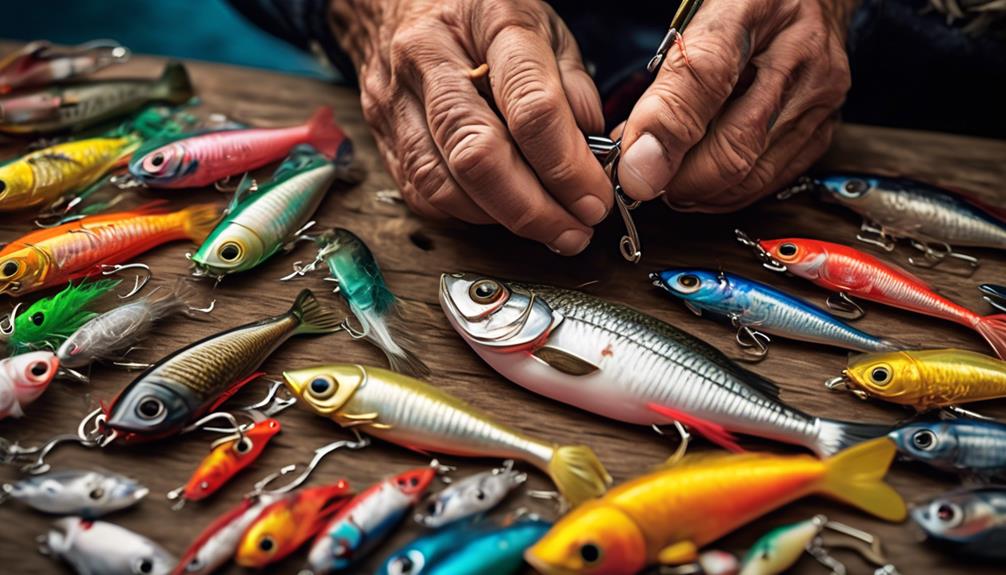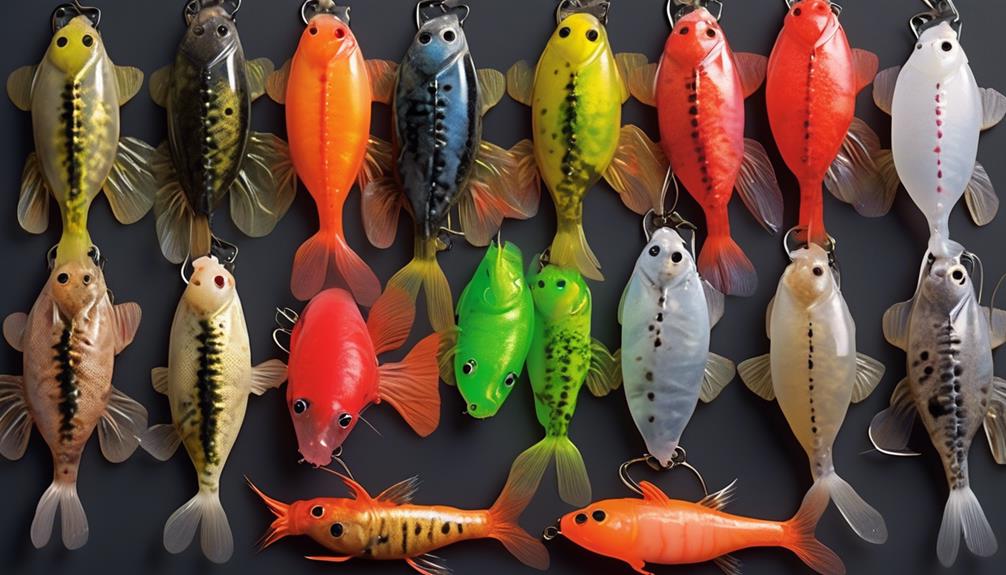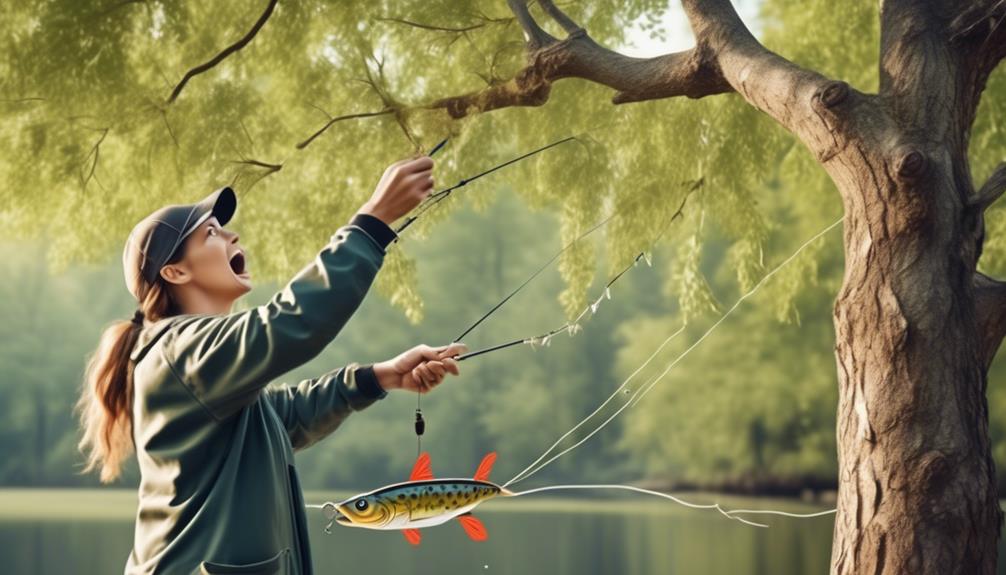When it comes to ice fishing, selecting the right baits and lures is key to catching your target species. Understanding the intricate interplay between fish behavior, local forage, and environmental conditions can mean the difference between a successful day on the ice and coming home empty-handed.
So, before you head out to the frozen waters, it's crucial to consider a multitude of factors that will give you the upper hand in enticing those elusive fish to bite.
Understanding Fish Behavior in Winter
In winter, fish tend to move slower and seek out deeper, more stable water to conserve energy and stay warm. This change in behavior is directly related to fish metabolism, which slows down in colder temperatures. Understanding this can greatly impact your ice fishing techniques.
When the fish's metabolism slows, their need for food decreases, making them less active and less likely to chase fast-moving lures. Therefore, it's essential to use baits and lures that can entice fish in these conditions.
Ice fishing techniques need to adapt to these behaviors. Since fish are in deeper, more stable water, your approach should involve drilling your holes in these areas. Additionally, using lures and baits that can be presented in a more subtle and slow manner is crucial. Small jigs or live bait suspended at the right depth are often successful in enticing sluggish fish.
Understanding the fish's behavior and metabolism in winter can help you choose the right baits and lures for ice fishing. It's not just about what you're using; it's about how you're using it to maximize your chances of a successful catch. By adapting your techniques to match the behavior and metabolism of fish in winter, you can significantly improve your ice fishing results.
Identifying Target Species
During the winter months, as fish metabolism slows and they seek deeper, more stable water, it's important to identify the specific species you're targeting for ice fishing success. Species selection is crucial in determining the bait preference for ice fishing. Different fish species have varying feeding habits and preferences, so understanding the target species is essential for a successful ice fishing expedition.
When identifying the target species for ice fishing, it's imperative to consider the behavior and feeding patterns of each species. For example, if you're targeting perch, you'll need to use smaller bait such as maggots or small minnows as they're known to feed on smaller prey. On the other hand, if you're aiming for larger predator species like pike or walleye, using larger bait such as smelt or large minnows may be more effective due to their predatory nature.
Understanding the specific species you're targeting also helps in selecting the appropriate bait presentation. Some fish species prefer live bait, while others may respond better to artificial lures. For instance, trout often respond well to jigs tipped with bait, while predatory species like pike may be attracted to flashy spoons or swimbaits.
Matching Bait to Local Forage
To effectively match bait to local forage when ice fishing, consider the natural food sources available to the target fish species in the specific body of water you're fishing. Forage selection plays a crucial role in determining bait effectiveness. Local prey availability directly influences lure choice, and understanding this connection can significantly enhance your ice fishing success.
Start by researching the common forage species in the body of water you plan to fish. Different bodies of water may have varying populations of forage, such as minnows, insect larvae, or smaller fish. Once you have identified the primary forage species, select baits and lures that closely resemble them in appearance, size, and movement.
For example, if the local forage consists of small minnows, using a small jigging spoon or a live minnow as bait can be highly effective. Similarly, if the target fish primarily feed on insect larvae, using small soft plastic baits that mimic insects can increase your chances of catching them.
Utilizing Natural Vs. Artificial Baits
Consider the advantages and disadvantages of using natural versus artificial baits when ice fishing to maximize your chances of enticing and catching fish. Both natural and artificial baits have their merits and drawbacks, and understanding when to use each can significantly impact your ice fishing success.
Natural vs. Artificial Baits
- Natural Bait: Using live bait such as minnows or worms can be highly effective as it closely mimics the natural food source of the fish. The movement and scent of live bait can be irresistible to predatory fish, increasing the likelihood of a strike. However, natural bait requires more maintenance and care to keep it alive and fresh in cold temperatures.
- Artificial Bait: Artificial lures offer a wide range of options in terms of colors, sizes, and shapes, allowing you to mimic various prey species. They're convenient, reusable, and don't require special storage or care. Additionally, artificial baits can be more versatile in different fishing conditions, such as when targeting specific depths or structures. However, some fish may have a preference for natural bait and may be less responsive to artificial lures.
- Bait Preference: Understanding the behavior and feeding habits of the target fish species is crucial when deciding between natural and artificial baits. Some fish may have a strong preference for natural bait, while others may readily strike at well-presented artificial lures.
Ultimately, the choice between natural and artificial baits depends on the specific fishing situation and the behavior of the fish you're targeting. Experimenting with both types of baits can help you determine what works best in different scenarios, ultimately leading to greater ice fishing success.
Exploring Lure Color and Size
When selecting lures for ice fishing, pay attention to the color and size variations to effectively attract and entice fish in different conditions.
Choosing effective coloration is crucial as it can significantly impact the success of your ice fishing expedition. In clearer water or under bright sunlight, consider using lures with natural and realistic color patterns such as silver, white, or light blue to mimic the appearance of baitfish.
In contrast, in murky or stained water, opt for lures with brighter and contrasting colors like chartreuse, orange, or pink to improve visibility and draw the attention of fish.
Understanding size variation is equally essential. In general, smaller lures are suitable for targeting panfish and smaller species, while larger lures are more effective for attracting predatory fish such as pike or walleye.
However, it's important to remain adaptable and be willing to experiment with different sizes based on the behavior and preferences of the fish in your specific ice fishing location.
Harnessing Scent and Attractants
Enhance your ice fishing success by incorporating scent and attractants into your lure presentation. Utilizing scent and attractants can significantly increase your chances of attracting fish in the icy waters. Here's how to harness scent and attractants effectively:
- Scent Effectiveness: Choose lures that allow you to add scent effectively. Look for lures with built-in scent chambers or porous materials that easily absorb scent. This will ensure that the scent is dispersed slowly and consistently, attracting fish over a longer period.
- Attractant Application: When applying attractants, ensure that it's done correctly to maximize its effectiveness. Apply the attractant liberally but not excessively. Too much attractant can overwhelm the fish and deter them from biting. Additionally, consider reapplying the attractant periodically, especially if you notice a decrease in bites. This will help maintain a strong and enticing scent trail in the water.
- Strategic Placement: Be strategic in where you apply the attractant on your lure. Focus on areas that will maximize its dispersal, such as porous areas or areas that create agitation in the water. This will ensure that the attractant creates a strong scent trail, drawing fish towards your lure.
Incorporating scent and attractants into your ice fishing strategy can make a significant difference in your catch rate. By understanding scent effectiveness and applying attractants strategically, you can enhance the appeal of your lures and increase your chances of a successful ice fishing expedition.
Adapting to Changing Conditions

Adapting to changing ice fishing conditions requires keen observation and quick decision-making to stay ahead of the game. One of the key factors to consider is ice thickness. As temperatures fluctuate, the thickness of the ice can change rapidly. It's crucial to constantly monitor the ice thickness as you move across the frozen water. Ice that was safe to fish on in the morning might become unsafe by the afternoon due to rising temperatures. Always be prepared to relocate if the ice conditions become questionable.
Temperature fluctuations also affect the behavior of fish. When the weather shifts, fish may move to different depths or areas of the water. Pay attention to any significant temperature changes and adjust your fishing tactics accordingly. For example, if there's been a sudden drop in temperature, fish may move to deeper waters where it's warmer. This means you might need to switch to different baits or lures that are better suited for deeper fishing.
In addition to temperature fluctuations, be mindful of any visible changes in the ice, such as cracks or areas of slush. These can indicate unstable conditions and prompt the need to move to safer areas. Always prioritize safety and be prepared to adapt your ice fishing strategies to the changing conditions.
Maximizing Depth and Presentation
As you adjust to changing ice fishing conditions, one key aspect to focus on is maximizing the depth and presentation of your baits and lures. To ensure you're effectively reaching the fish, consider the following:
- Maximizing Visibility: In the crystal-clear waters beneath the ice, visibility is key. Opt for brightly colored baits and lures to enhance their visibility to fish. Fluorescent oranges, pinks, and yellows can attract attention even in low light conditions. Additionally, adding reflective elements to your lures can further increase their visibility, making them stand out in the water.
- Adjusting Retrieval Speed: Fish can be more lethargic in the cold water, so altering your retrieval speed can make a significant difference. Varying your retrieval speed allows you to mimic the movements of natural prey, enticing fish to strike. Experiment with slow and steady retrieves, as well as occasional pauses, to find the optimal presentation for enticing bites.
- Utilizing Depth Finders: Invest in a quality depth finder to accurately determine the depth at which the fish are located. This tool will enable you to adjust your bait or lure depth accordingly, ensuring you're presenting your offerings at the most effective levels for enticing bites.
Frequently Asked Questions
Are There Any Regulations or Restrictions on the Types of Baits and Lures That Can Be Used for Ice Fishing in Different Locations?
In different ice fishing locations, regulations and restrictions may vary when it comes to the types of baits and lures that can be used.
It's important to check local regulations to ensure you're using approved bait and lures.
Certain areas may have specific rules about live bait or artificial lures, so being aware of these regulations will help you make the right bait and lure selection for your ice fishing adventures.
How Can I Determine the Best Bait or Lure to Use if I Am Targeting Multiple Species of Fish in the Same Area?
When targeting multiple species in the same area, finding the best bait or lure is crucial. Consider the natural prey of the fish species you're targeting. Choose versatile lures that mimic various types of prey, such as small fish, insects, or larvae.
Experiment with different colors and sizes to attract a wider range of fish. Lure selection is key to enticing multiple species in the same area, so be adaptable in your approach.
What Are Some Tips for Storing and Preserving Natural Baits, Such as Minnows or Worms, During Ice Fishing Trips?
When ice fishing, you should store natural baits like minnows or worms properly to keep them fresh. Place them in a well-insulated cooler with ice packs or in a bait container with damp moss to maintain their freshness and liveliness.
Avoid leaving them exposed to extreme temperatures. Additionally, consider using bait preservatives or additives to extend their shelf life and effectiveness.
These storing tips and preserving techniques will help you maximize your chances of a successful ice fishing trip.
Are There Any Specific Techniques or Strategies for Using Scents and Attractants With Artificial Baits in Ice Fishing?
When ice fishing, using pheromone scents can enhance your success. Experiment with different attractants to find what works best in your area.
Incorporating a scent trail can entice fish to strike. Adjust bait and lure placement to maximize the effectiveness of the scents and attractants.
These techniques can help you lure in more fish during your ice fishing trips.
How Can I Modify My Bait or Lure Presentation to Attract Fish in Heavily Pressured or Over-Fished Ice Fishing Areas?
To attract fish in heavily pressured or over-fished ice fishing areas, modify your bait or lure presentation. Experiment with different sizes, colors, and movements to entice bites.
Use smaller, more natural-looking baits, and try varying retrieval speeds.
Additionally, consider using scents or attractants to enhance the appeal of your bait.
Conclusion
So, when you're out on the ice, it's important to choose the right baits and lures to maximize your chances of catching fish.
By understanding fish behavior, identifying your target species, and matching your bait to local forage, you can increase your success.
Whether you prefer natural or artificial baits, paying attention to color, size, and scent can make a big difference.
Don't forget to adapt to changing conditions and maximize your depth and presentation for the best results.
Happy fishing!



